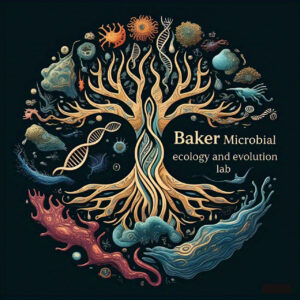 Microorganisms are key mediators in nearly all of the planet’s elemental cycles. However, our understanding of the ecological roles of many groups of microbes has been hampered by low-resolution analytical approaches to studying the staggering diversity present in nature. As a result, the tree of life is full of branches which remain undiscovered, and others, which have only been identified in single-gene sequencing surveys (Baker and Dick, 2013). This is a fundamental gap in our understanding of biology. Filling in the genomic gaps in the tree of life will provide a rich context to understand the evolution of life on the planet and will provide us with a genetic understanding of how microbial communities drive biogeochemical cycles.
Microorganisms are key mediators in nearly all of the planet’s elemental cycles. However, our understanding of the ecological roles of many groups of microbes has been hampered by low-resolution analytical approaches to studying the staggering diversity present in nature. As a result, the tree of life is full of branches which remain undiscovered, and others, which have only been identified in single-gene sequencing surveys (Baker and Dick, 2013). This is a fundamental gap in our understanding of biology. Filling in the genomic gaps in the tree of life will provide a rich context to understand the evolution of life on the planet and will provide us with a genetic understanding of how microbial communities drive biogeochemical cycles.
Recent advances in DNA sequencing technologies and computational analyses have made it possible to reconstruct the genomes and transcriptomes of uncultured natural populations (Baker et al. 2010, 2012 and 2013). I have been involved in the development (Dick et al. 2009) and implementation of environmental omics since the beginning. I was involved in the first metaproteomic study of a microbial community, (Ram et al. 2005) and have been using these approaches to track fine-scale evolutionary processes (Denef et al. 2010). Using these techniques I discovered deeply branching, novel groups of microbes (Archaea referred to as ARMAN) that are close to the predicted lower size limit of an organism (Baker et al. 2006). Obtaining complete genomes of the ARMAN phylum revealed that they have signatures of inter-species interactions and form connections to other species in nature (Baker et al. 2010).
Topic 1 – Enlightening the physiologies of uncultured marine sediment microbes
The focus of this ongoing research has resulted in the first glimpses into the physiological capabilities of numerous uncultured and newly discovered branches on the tree of life. Microbes in marine sediments play key roles in the recycling of organic carbon from the oceans. However, due to culturing biases, little is known about how these communities process organic carbon and cycle nutrients (e.g. nitrogen, sulfur). To do this, we have reconstructed hundreds of genomes from a variety of different marine sediments around the world. These include a variety of habitats from coastal estuaries to deep oceans. For example, from a recent study of an estuary (White Oak River, in North Carolina) we have analyzed the metabolisms of diverse uncultured archaea and have shown that they have a broad ability to process lipids, proteins, and complex carbohydrates (Lazar et al. 2017). In another study of deep sediments from the South China Sea, we have shown that several new lineages of microbes are able to fix CO2 as a source of carbon (Huang et al. In review). This suggests that these sediment communities are not entirely reliant on organic carbon for survival.
The most active environment my group has been focusing on in the last year is hydrothermal vent-associated sediments from the Guaymas Basin. These sediments are unique because they receive a high amount of organic matter from the overlying water which is then transformed by hydrothermal circulation into petroleum-like hydrocarbons. We recently published the first set of samples from this site, which has begun to delineate the nutrient cycling among different microbial groups (Dombrowski et al. 2017). Interestingly, we have also discovered new pathways for hydrocarbon utilization in several uncultured microbes, including a common group referred to as “GoM-Arc1”. Continuing work at Guaymas Basin has resulted in the reconstruction of over 800 additional genomes. Nearly all of these genomes form new branches within archaea and bacteria. These genomes are being analyzed and will result in several new transformative ecological discoveries. We have also obtained a grant from the DOE for large-scale genomic and transcriptomic sequencing estuaries in South Texas. This will provide my group with a massive amount of data (60 lanes of Illumina) to characterize these communities.
Topic 2 – The metabolic roles of Asgard archaea and the origin of eukaryotes
Recently, it has been shown that microbes belonging to the Asgard archaea are phylogenetically related to eukaryotes. This finding has received considerable attention in the biology community, as it reshapes our understanding of the tree of life. These fascinating organisms are widespread in sediments, and we have obtained genomes belonging to newly described phyla, namely: Thorarchaeota, Odinarchaeota, and Heimdallarchaeota. These related lineages have been named the Asgard superphylum. We have been collaborating with Dr. Thijs Ettema’s laboratory to describe the evolutionary roles of these archaea in the origin of complex cellular life, eukaryotes (Zaremba-Niedzwiedzka et al. 2017).
We have recently obtained several dozens of additional Asgard genomes from deep sea sediments. Taxonomic analyses of these genomes revealed they significantly expand the Asgard biodiversity, including the additional new phyla named Freyarchaeota and Helarchaeota. We are currently analyzing the metabolic capabilities of these new archaea. This is providing us with new insights into the metabolic processes of early eukaryotic life. In addition, this new genomic data is being used to determine which of the Asgard archaea are most closely related to eukaryotes. Resolving this will be integral to advancing our understanding of the genetic composition of the first eukaryotic cells.
